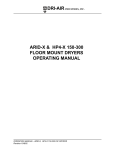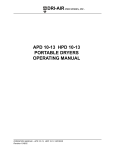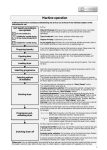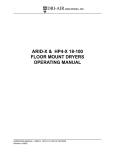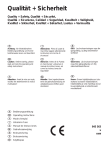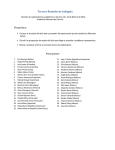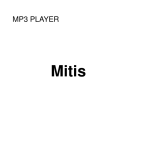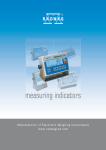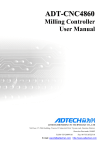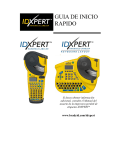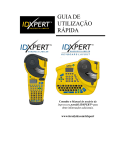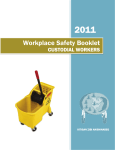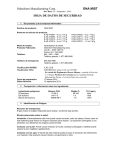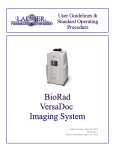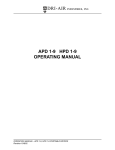Download Tender Corporation After Sting Jellyfish
Transcript
MATERIAL SAFETY DATA SHEET SAFETY DATA SHEET Prepared according to 29CFR 1910.1200, Regulation (EC) No. 1272/2008 (GHS) and Canadian Controlled Products Act (CPR) SECTION 1: PRODUCT AND COMPANY IDENTIFICATION PRODUCT NAME: Product Code: MSDS Date: MSDS Revision No.: USE: MANUFACTURER: ADDRESS: INFORMATION CALLS: E-Mail: FAX PHONE: EMERGENCY PHONE: After Sting® Gel; After Bite Xtra ®; After Bite® Gel After Bite® Outdoor; After Bite® Chigger/Ant 0001-1113 April 23, 2012 4 Insect bite treatment HMIS Hazard Rating HEALTH FLAMMABILITY REACTIVITY PERSONAL PROTECTION 2 0 0 X Tender Corporation 106 Burndy Road Littleton, NH 03561 800-258-4696 [email protected] 603-444-6735 Spills :(800) 354-2382 (Veolia) Medical Information :(800) 258-4696 (Tender Corporation) SECTION 2: HAZARDS IDENTIFICATION EMERGENCY OVERVIEW: Opaque non-flammable water soluble gel with a strong ammonia odor HAZARD CLASSIFICATION: Warning GHS Label elements, including precautionary statements Pictogram Signal word: WARNING Hazard statement(s) H302 H319 H315 H412 Precautionary statement(s) P102 P234 P305+P351+P338 P301+330+331+315 P273 ROUTES OF EXPOSURE: Harmful if swallowed Causes serious eye irritation Causes skin irritation Harmful to aquatic organisms and may cause long-term adverse effects in the aquatic environment Keep out of the reach of children Keep in original container IF IN EYES; Rinse cautiously with water for several minutes. Remove contact lenses, if present and easy to do. Continue rinsing IF SWALOWED: Rinse mouth. DO NOT induce vomiting. Get immediate medical advice/attention. Avoid release to the environment Dermal, oral POTENTIAL HEALTH EFFECTS INHALATION: May cause irritation to lungs SKIN CONTACT: Do not use over cuts, wounds or irritated skin Pre-existing skin disorders may be aggravated by exposure EYE CONTACT: Prolonged contact may cause irritation, with redness, pain, tearing, blurred vision and conjunctivitis. INGESTION: May be harmful if swallowed. Product Code: 0001-1113 Page 1 of 6 Date Printed: 31 October 2013 MATERIAL SAFETY DATA SHEET SAFETY DATA SHEET Prepared according to 29CFR 1910.1200, Regulation (EC) No. 1272/2008 (GHS) and Canadian Controlled Products Act (CPR) SECTION 3: COMPOSITION/INFORMATION ON INGREDIENTS Ingredient Ammonia Water Sodium Bicarbonate Carbomer (Polyacrylic acid) Melaleuca alternifolia Conc.( %) 3.5% 84.0 to 88.0 1.0 to 3.0 1.0 to 2.5 0.3 to 0.5 CAS NO. 7664-41-7 7732-18-5 144-55-8 9003-01-4 85085-48-9 EINECS NO. 231-635-3 231-791-2 205-633-8 N/A 285-377-1 Classification EU-Xi ; WHMIS-Class E None None None EU-Xn See Section 8 – “EXPOSURE CONTROLS/PERSONAL PROTECTION” for exposure guidelines SECTION 4: FIRST AID MEASURES INHALATION: Move victim to fresh air. Apply artificial respiration if indicated. Contact a physician if warranted. CONTACT WITH SKIN: Take off contaminated clothing. Immediately wash gently and thoroughly with luke warm, gently flowing water and non-abrasive soap for 15-20 mins. If skin irritation or rash occurs, see a doctor. Thoroughly clean clothing before reuse or dispose of safely. CONTACT WITH EYES: Immediately flush the contaminated eye(s) with lukewarm, gently flowing water for 15-20 minutes, while holding the eyelid(s) open. Remove contact lenses, if present and easy to do. Take care not to rinse contaminated water into the unaffected eye or onto the face. If irritation or pain persists, see a doctor. INGESTION: Have victim rinse mouth with water. NEVER give anything by mouth if the victim is rapidly losing consciousness, or is unconscious or convulsing. DO NOT INDUCE VOMITING. Contact a physician if warranted. SECTION 5: FIRE-FIGHTING MEASURES FIRE AND EXPOLSIVE PROPERTIES: Non Flammable - This product is not flammable, combustible or explosive Flash Point: Not applicable Flammable Limits: Not applicable EXTINGUISHING MEDIA: Water spray Carbon dioxide Dry Chemical or foam SPECIFIC HAZARDS: In case of fire, hazardous combustion gases may be formed: Carbon monoxide (CO) Carbon Dioxide (CO2) Nitrogen oxides (NOx) PROTECT EUIPMENT FOR FIREFIGHTERS: Use self-contained breathing apparatus and full protective clothing FURTHER INFORMATION: Fire residues and contaminated firefighting water must be disposed of in accordance with local regulations SECTION 6: ACCIDENTAL RELEASE MEASURES PERSONAL PRECAUTIONS: For Large Spills; Isolate the hazard area. Keep out unnecessary and unprotected personnel. Increase ventilation to area or move leaking container to a well-ventilated and secure area. Use the Personal Protective Equipment recommended in Section 8 of this MSDS. Review Section 7 (Handling) of this MSDS before proceeding with cleanup. ENVIRONMENTAL PRECAUTIONS: Do not allow into any sewer, on to ground or into any waterway. METHOD FOR CONTAINMENT AND CLEAN-UP: Prevent product from entering drains and ventilation systems. Contain and soak up spill with absorbent that does not react with spilled product. Place used absorbent into suitable, covered labeled containers for disposal. Large Spills: Dike spill product to prevent runoff. Recover contaminated water for appropriate disposal. Report spills to local health, safety and environmental authorities, as required. Product Code: 0001-1113 Page 2 of 6 Date Printed: 31 October 2013 MATERIAL SAFETY DATA SHEET SAFETY DATA SHEET Prepared according to 29CFR 1910.1200, Regulation (EC) No. 1272/2008 (GHS) and Canadian Controlled Products Act (CPR) SECTION 7: HANDLING AND STORAGE HANDLING: STORAGE: Read entire label before using. Use strictly in accordance with label precautionary statements and directions. Do not contaminate food or feed. Keep product in its original container. Keep container tightly closed. Store this product in a cool, dry place away from heat or direct sunlight. Protect from freezing. SECTION 8: EXPOSURE CONTROLS/PERSONAL PROTECTION ENGINEERING CONTROLS: General ventilation is usually adequate. When handling large quantities of concentrated product; Use local exhaust ventilation, if necessary. PERSONAL PROTECTIVE EQUIPMENT (PPE): None required. EXPOSURE GUIDELINES: INGREDIENT: Ammonia CAS NO. % 7664-41-7 Exposure Limits < 3.5% ACGIH TLV-TWA ACGIH TLV-STEL 18 mg/m3 (TWA -25ppm) 40 ppm as STEL OSHA PEL-TWA SECTION 9: PHYSICAL AND CHEMICAL PROPERTIES APPEARANCE: Opaque gel ODOR: Ammonia pH: 10.0 to 12.0 BOILING POINT: Not determined MELTING POINT: Not applicable RELATIVE DENSITY (H2O = 1) @25˚C: 1.00 gm/ml VAPOR PRESSURE (mmHg) @ ˚C: Not applicable VAPOR DENSITY (AIR = 1): Not applicable FLASH POINT: Not expected for water-based product SOLUBILITY IN WATER: Complete SOLUBILITY IN SOLVENTS: Not determined VISCOSITY: 30,000 cps @ 25º C VOLATILE ORGANIC COMPOUNDS (VOC): Not determined PARTITION COEFFICIENT: Not determined SECTION 10: STABILITY AND REACTIVITY STABILITY: Stable CONDITIONS TO AVOID: Extreme temperatures, Sunlight INCOMPATIBILITY (MATERIAL TO AVOID): Metals and Oxidizing agents. Attacks many metals forming explosive gas. Reacts violently with acids Strong acids, most common metals, strong oxidizing agents, bromine, chlorine, aluminum, copper, brass, bronze, hypochlorite, acids, monoammonium phosphate, sodium potassium alloy, strong alkalis or mineral acids. HAZARDOUS DECOMPOSITION OR BY-PRODUCTS: Ammonia, Carbon dioxide, Carbon monoxide, Nitrogen oxides HAZARDOUS POLYMERIZATION: Product Code: 0001-1113 2013 Will not occur Page 3 of 6 Date Printed: 31 October MATERIAL SAFETY DATA SHEET SAFETY DATA SHEET Prepared according to 29CFR 1910.1200, Regulation (EC) No. 1272/2008 (GHS) and Canadian Controlled Products Act (CPR) SECTION 11: TOXICOLOGICAL INFORMATION The preparation has not been tested for all toxicological effects; some are classified on the basis of the known hazards of the components. Acute oral toxicity: LD50 – Greater than 2000 mg/kg female rat Method: OPPTS 870.1100, OECD 425 Source: Product Tested 2005 Acute inhalation toxicity: LC50 – Not determined Method Source: Acute dermal toxicity: LD50 – Not determined Method: Source: Irritant effect on skin: Moderately irritating, slightly irritating at 72hrs (PDII: 3.4) Method: OPPTS 870.2500, OECD 404 Source: Product Tested 2005 Irritant effect on eyes: Severely irritating, irritation cleared by 17 days (MMTS 34.7) Method: OPPTS 870.2400, OECD 405 Source: Product Tested 2005 Sensitization: No ingredient has been identified as having sensitizing properties. Method Source: Literature Mutagenicity: Not determined Method Source: Carcinogenicity/Reproductive toxicity: No components present in this material at concentrations of 0.1% or greater are listed by IARC, NTP, OSHA or ACGIH as being carcinogens. Source: Safety Data Sheets of components Specific Target Organ Toxicity Single exposure (GHS) – no data available Repeated exposure (GHS) - no data available Redness, rash or blistering Signs and Symptoms of Exposure POTENTIAL HEALTH EFFECTS INHALATION: May cause irritation to lungs SKIN CONTACT: Pre-existing skin disorders may be aggravated by exposure EYE CONTACT: Prolonged contact may cause irritation, with redness, pain, tearing, blurred vision and conjunctivitis. INGESTION: Harmful if swallowed SECTION 12: ECOLOGICAL INFORMATION General Comments: Ecotoxicological data have not been determined specifically for this product, but it is classified on the basis of the known hazards of the components. This section is not required by WHMIS. Mobility The product is water-based and expected to be mobile in the aquatic environment. Persistence/degradability The Ammonium Hydroxide is readily biodegradable in the environment, according to ECBI/07/00 Rev. 3 (29/8/00) The Ammonium Hydroxide has been shown to have a low bioaccumulation. (Log POW=2,02) The Ammonium Hydroxide has been shown to be toxic to aquatic organisms. (10mg/l<LC50 <100 mg/l) Bioaccumulation Toxicity Product Code: 0001-1113 2013 Page 4 of 6 Date Printed: 31 October MATERIAL SAFETY DATA SHEET SAFETY DATA SHEET Prepared according to 29CFR 1910.1200, Regulation (EC) No. 1272/2008 (GHS) and Canadian Controlled Products Act (CPR) SECTION 13: DISPOSAL CONSIDERATIONS WASTE DISPOSAL METHOD: Do not reuse any empty containers. US: This product is not a hazardous solid waste as defined in Resource Conservation Recovery Act Regulations (40 CFR 261)and should be disposed of according to local, state and Federal regulations Dispose of partially filled and empty containers by wrapping and discarding in trash. International: This product should not be disposed of via the drains or by landfill. Disposal must be in accordance with current national and local regulations. Chemical residues generally count as special waste, and their disposal may be regulated in the EC member countries through corresponding laws and regulations. We recommend that you contact either the authorities or approved waste disposal companies who will advise you on how to dispose of special waste. Packaging may contain residues of the product and should be treated accordingly. General EU requirements are given in the Waste Framework Directive (75/442/EEC) and the Hazardous Waste Directive (91/689/EEC). SECTION 14: TRANSPORT INFORMATION SHIPPING INFORMATION: Regulation UN No. Proper Shipping Name Class Marine Pollutant: No Label Additional Information Not regulated _ U.S. Department of Transportation (DOT) – Non-Bulk U.S. Department of Transportation (DOT) – Bulk _ _ _ Package Group _ 3266 Corrosive liquids, n.o.s. Ammonium Hydroxide 8 III C Corrosive Canadian Transportation of Dangerous Goods (TDG) Non-Bulk International Maritime Dangerous Goods (IMDG) Non-Bulk International Air Transport Assoc. (IATA) Non-Bulk _ Ammonium Hydroxide 8 _ E Corrosive _ _ _ _ _ Not regulated _ _ _ _ _ Not regulated The transportation regulations are cited according to international regulations and in the form applicable to the United States and Canada. Possible national deviations in other countries are not considered. SECTION 15: REGULATORY INFORMATION U.S. FEDERAL REGULATIONS: TSCA (TOXIC SUBSTANCE CONTROL ACT): All components of this product are listed or exempt on the TSCA list CERCLA (COMPREHENSIVE RESPONSE COMPENSATION, AND LIABILITY ACT): CERCLA HAZARDOUS SUBSTANCE: Ammonium hydroxide (CAS # 1336-21-6) CERCLA REPORTABLE QUANITIY: RQ= 500lbs RCRA 261 (RESOURCE CONSERVATION RECOVERY ACT): Ammonium hydroxide (CAS # 1336-21-6) SARA TITLE III (SUPERFUND AMENDMENTS AND REAUTHORIZATION ACT) Section 302 Extremely Hazardous Substances (TPQ): TPQ=500lbs. 311/312 HAZARD CLASS: Acute Health and Chronic Health Hazard. 313 REPORTABLE INGREDIENTS: Ammonium hydroxide (CAS # 1336-21-6) California Proposition 65: None States Right to Know: This product contains Ammonium hydroxide (CAS # 1336-21-6) CANADIAN REGULATIONS: WHMIS CLASSIFCATION: Class E- Corrosive This product has been classified in accordance with the hazard criteria of the CPR and the MSDS contains all the information required by the CPR. DOMESTIC SUBSTANCE LIST (DSL)/NON-DOMESTIC SUBSTANCE LIST (NDSL): All components are listed or exempt Canadian Ingredient Disclosure List: Ammonium hydroxide (CAS # 1336-21-6) Product Code: 0001-1113 2013 Page 5 of 6 Date Printed: 31 October MATERIAL SAFETY DATA SHEET SAFETY DATA SHEET Prepared according to 29CFR 1910.1200, Regulation (EC) No. 1272/2008 (GHS) and Canadian Controlled Products Act (CPR) EU REGULATIONS: Labeling in accordance with EC-Directives Hazard symbols Irritant Corrosive Toxic to Aquatic Organisms Hazardous component(s) to be indicated on label: Contains Ammonium hydroxide EC Number R phrases 22 Harmful if swallowed 36/37/38 Irritating to eyes, skin and respiratory system S phrases 1/2 26 45 49 61 Keep locked and out of the reach of children In case of contact with eyes, rinse immediately with plenty of water and seek medical advice in case of accident or if you feel unwell seek medical advise immediately Keep only in the original container avoid release to the environment. Refer to special instructions/safety data sheet. SECTION 16: OTHER INFORMATION HMIS Health: 2 Special: Corrosive Flammability: 0 Reactivity: 0 4=extreme 3=High 2=Moderate 1=Slight 0=Insignificant REVISED SECTIONS OR REASON FOR REVISION: ISSUED DATE: OCT 22, 2007 1-(1-13-2009)-NAME ADDITION 2-(5-14-2010)-NEW WHIMIS & EU COMPLIANT FORMATTTING 3-(6-21-2010)-NEW GHS FORMATTING – SPEC CHANGE TO SP.GR. & PH 4-(4-23-12) - MEDICAL INFORMATION PHONE # & ADDED E-MAIL ADDRESS, PRINT DATE, PRODUCT CODE, INGREDIENT RANGES DISCLAIMER: The information provided herein was believed to be accurate, to the best knowledge of Tender Corporation, at the time of preparation from a compilation of sources believed to be reliable and is furnished without warranty, expressed or implied. It is the responsibility of the user to investigate and understand other pertinent sources of information, to comply with all laws and procedures applicable to the safe handling, storage and use of this product and to determine the suitability of the product for its intended use. This data sheet relates only to the specific product listed and does not relate to use in combination or in any process with other materials Product Code: 0001-1113 Page 6 of 6 Date Printed: 31 October 2013






